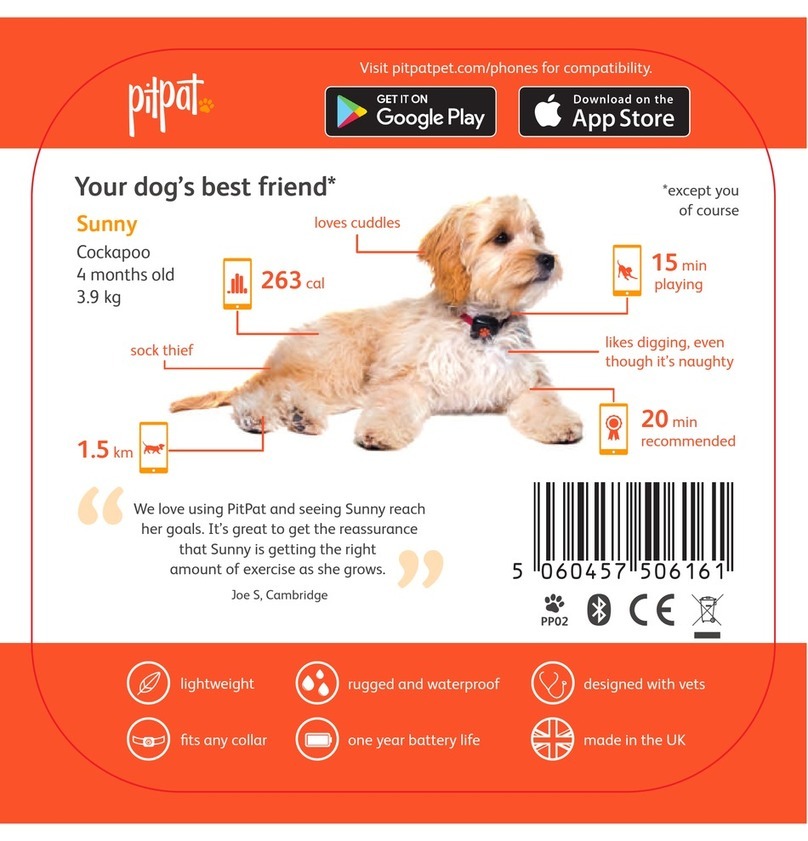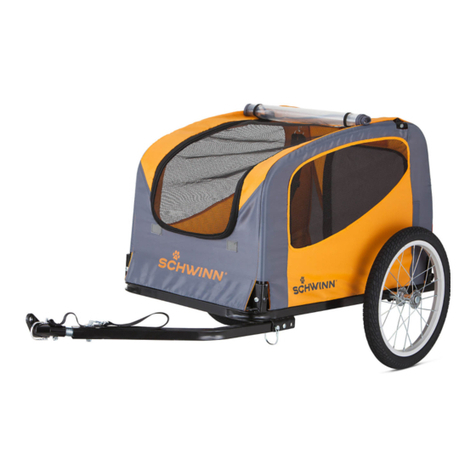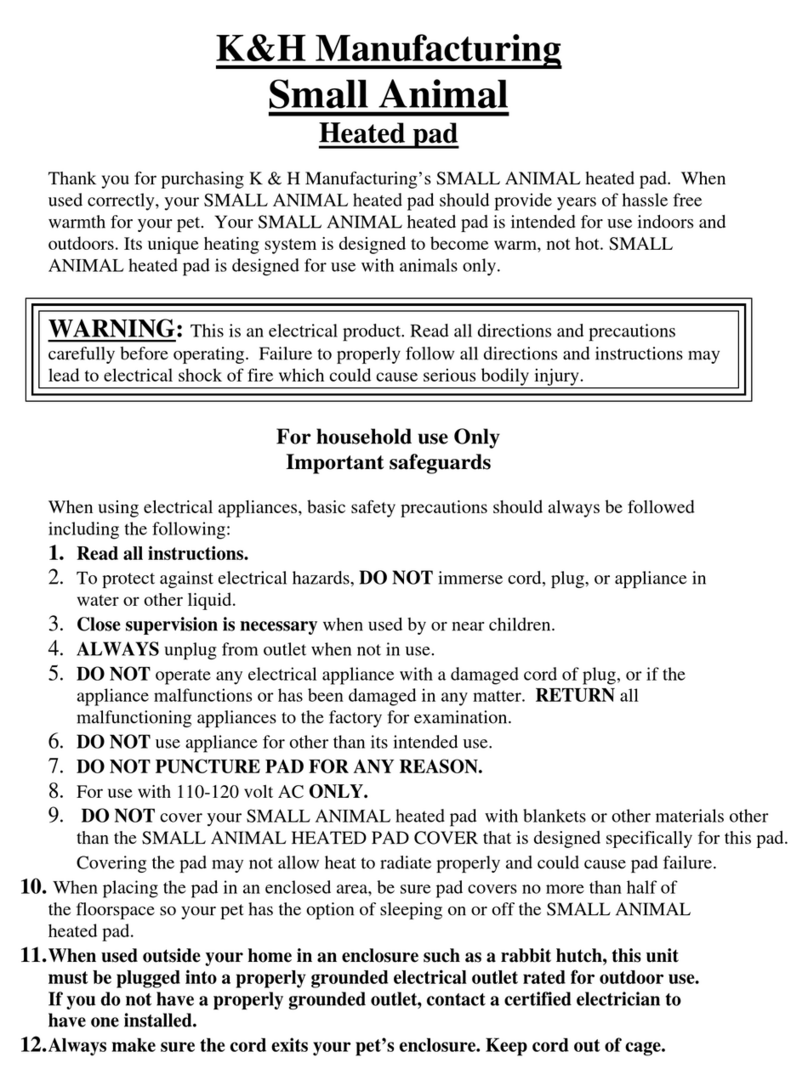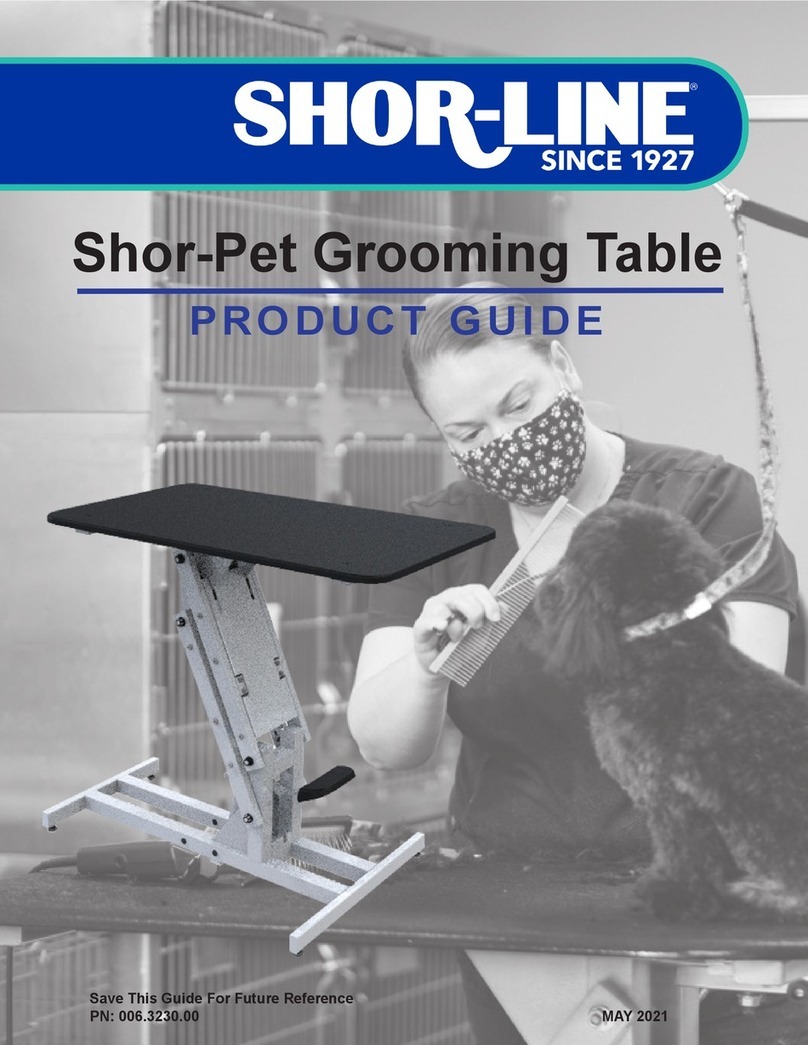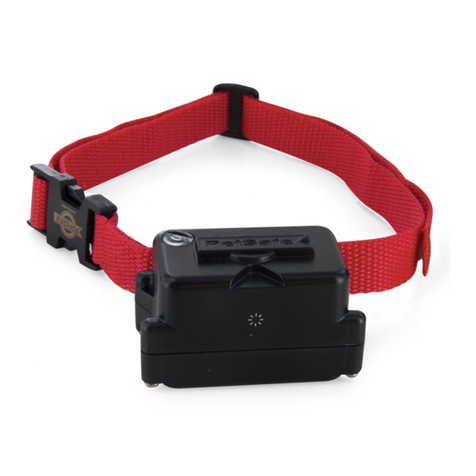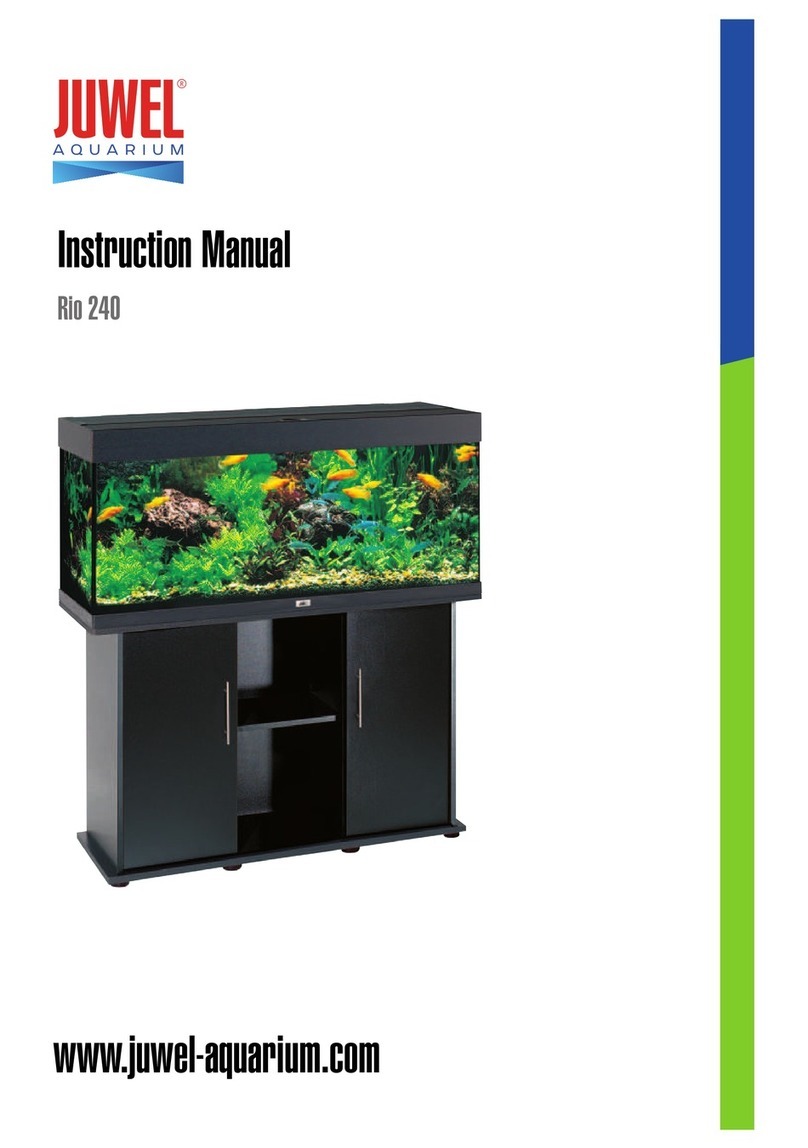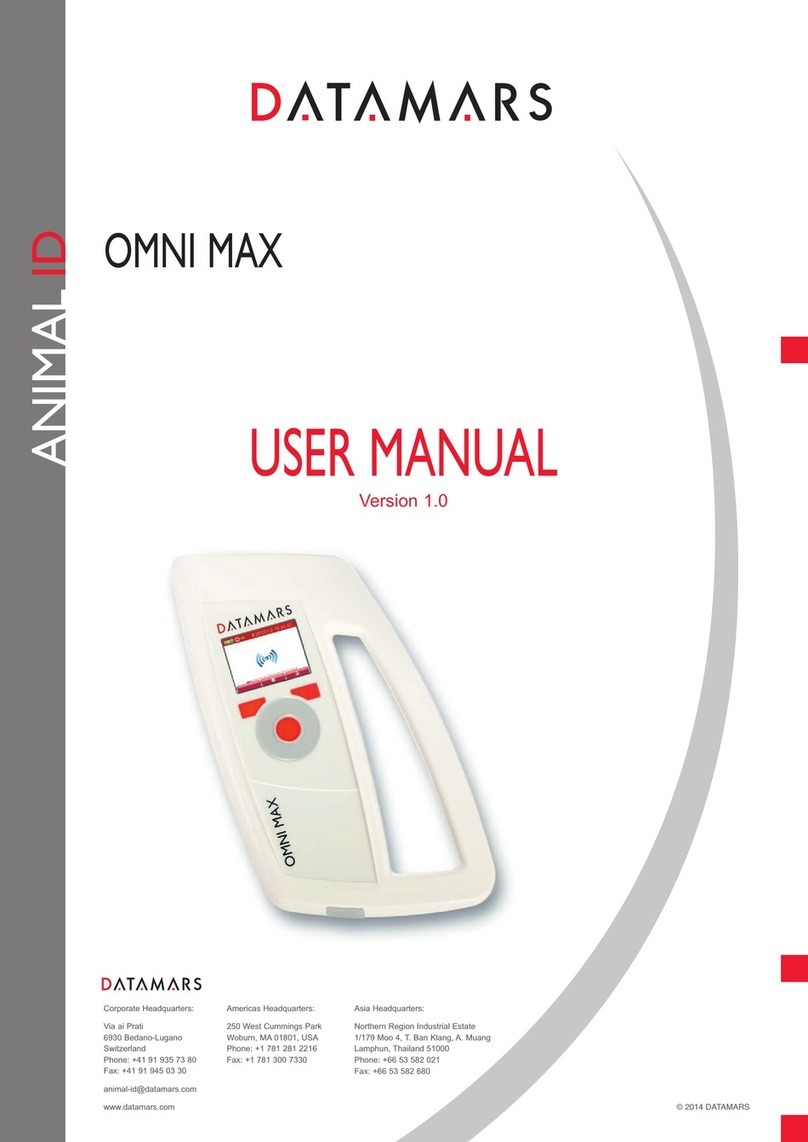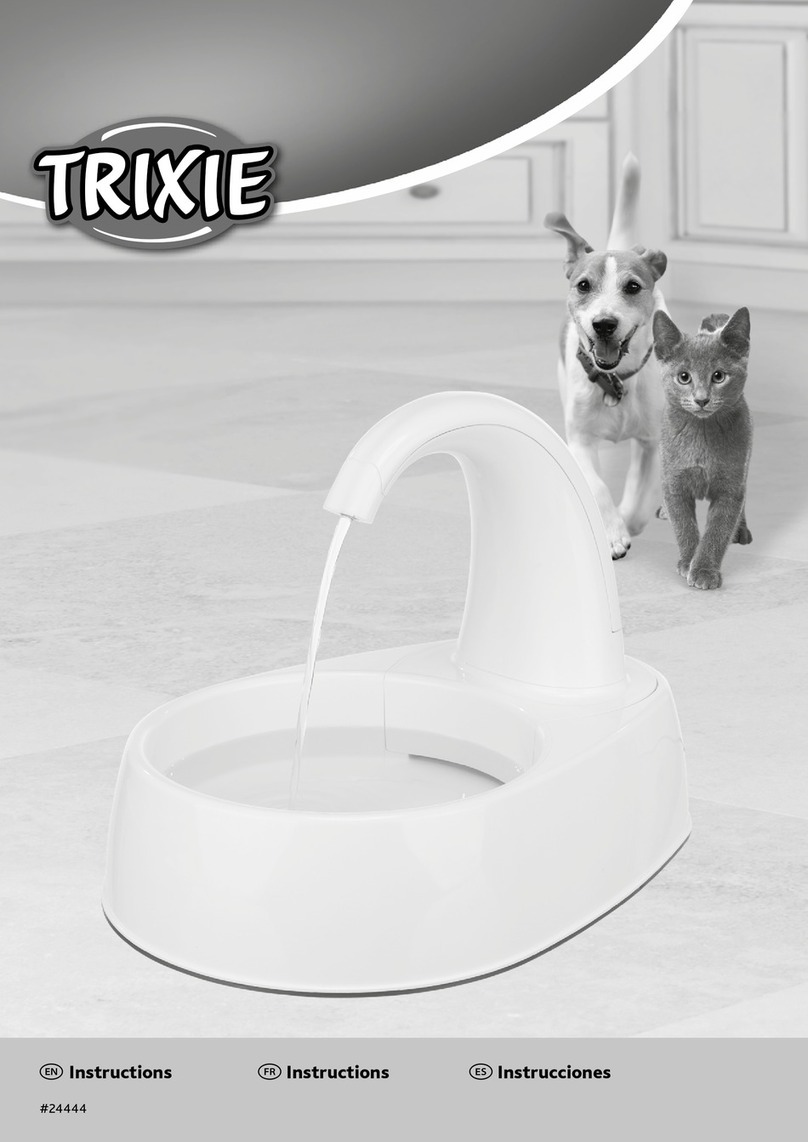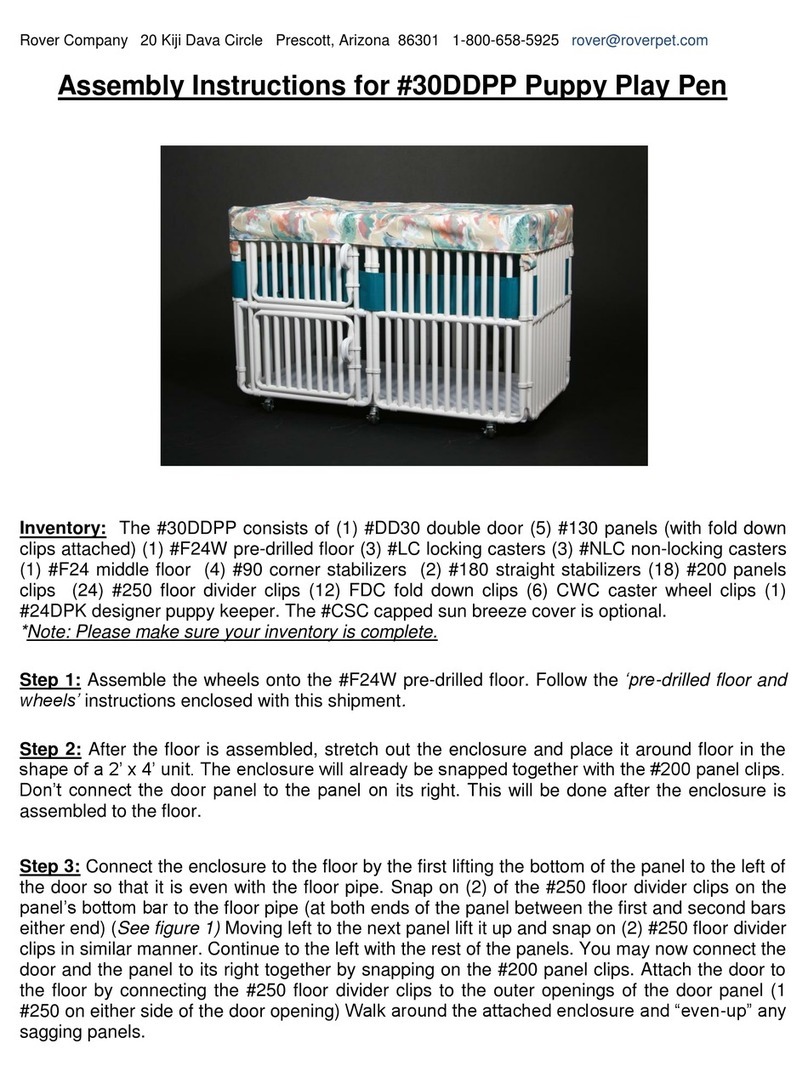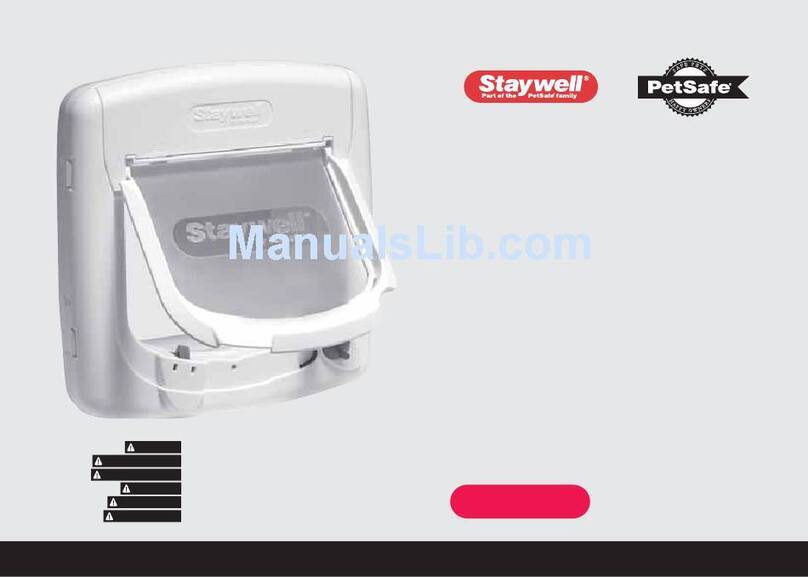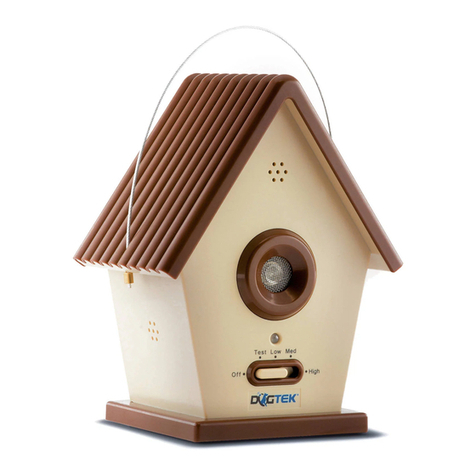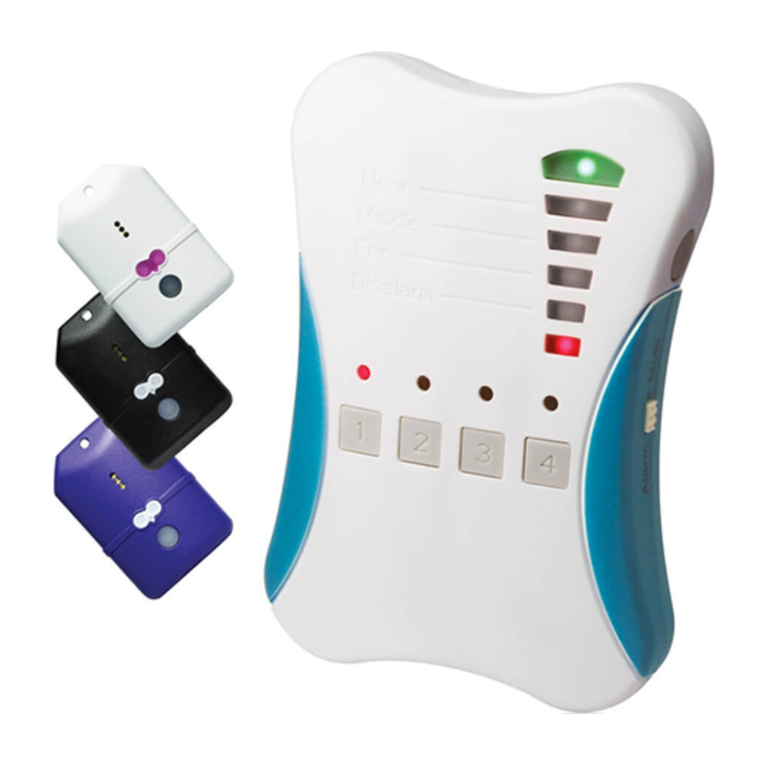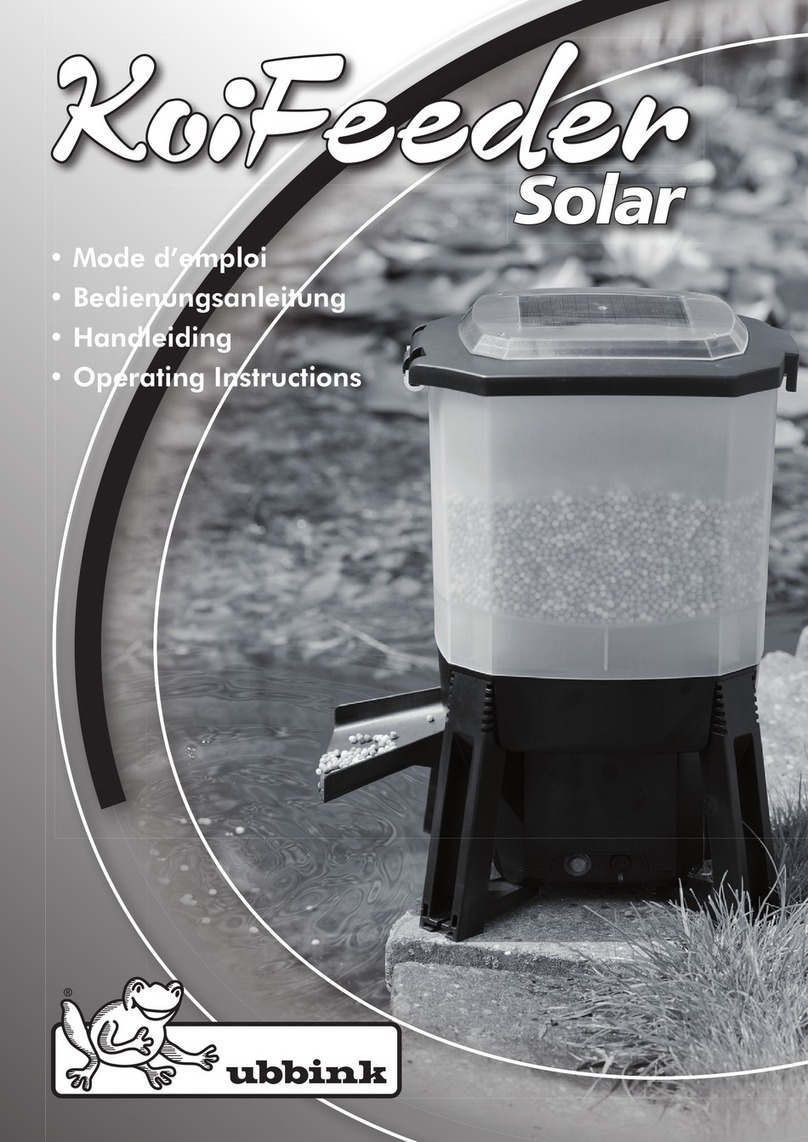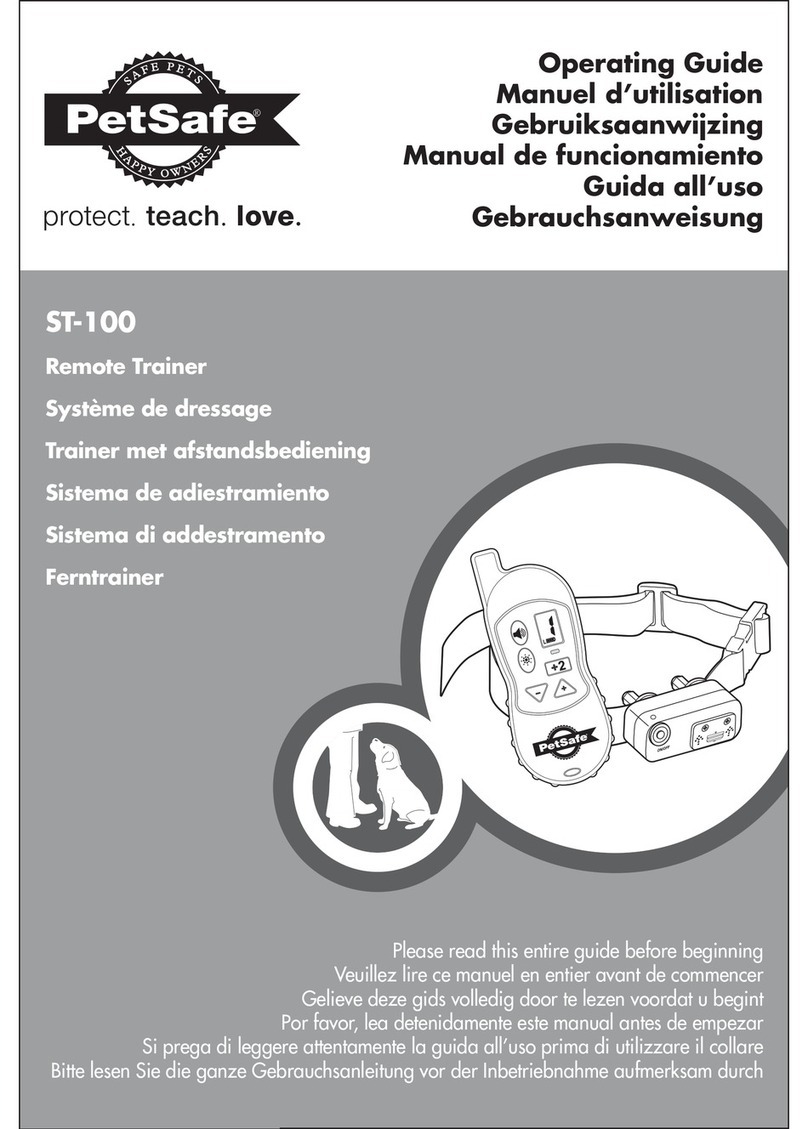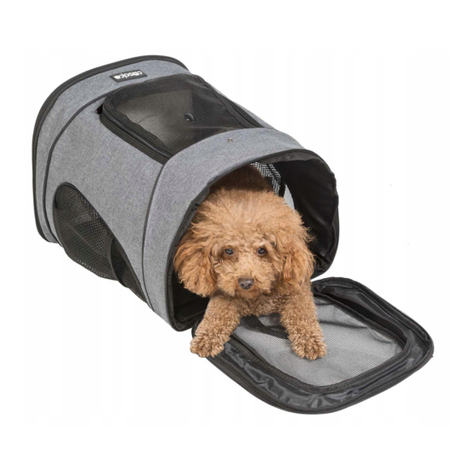Heiniger C12 User manual

Betriebsanleitung
Instruction manual
Mode d’emploi
Istruzioni d’uso
Manual de instrucciones
Bedieningshandleiding
Instruktionsbog
Instruktionsbok
Instruksjonsbok
Käyttöohjekirja
Manual de instruções
δηγίες ρήσης
swiss made
Ausgabe/Index: C12/C 11-11

2 Instruction manual C12
Contents
1 Proper Use
1.1 Overall View / Controls
1.2 Intended Use
1.3 Technical Data
1.4 Equipment Items
2 Safety Regulations
2.1 Introduction
2.2 Symbols and Warning Signs
2.3 Proper Use
2.4 Safety Principles
2.4.1 Power Connections
2.4.2 Servicing and Checking Requirement
2.4.3 Noise Emission / Personal Protective Equipment
2.4.4 Other Dangers
2.5 Essential Operator Skills
3 Putting into Operation
3.1 Controls and Operating Notes
3.2 Setting the Clipper Blades with the Adjusting Screw
3.3 Lubrication
3.4 Switching On / Off
3.5 Malfunctions
4 Servicing
4.1 Cleaning
4.2 Fitting the Clipper Blades
4.3 Resharpening the Clipper Blades
4.4 Cleaning the Air Filter
4.5 Changing the Clipper/Shear Head (Option)
4.6 Storing the Clipping Machine
5 Repairs
5.1 Introduction
5.2 Malfunction Lists
6 Environmental Protection and Disposal
6.1 Introduction
6.2 Material Categories
7 Contact Addresses
Illustrations: at the end of the instructions

Instruction manual C12 3
POS
DESCRIPTION
22 Spindle VS84/12V 1x
23 Countersunk screw M4 x 12 2x
24 Seal VS84/HANDY/12V 1x
25 Centering flange 12V 1x
26 Motor with cogwheel 12V 1x
27 Fan wheel 12V 1x
28 T-wire 1.5mm² red with flat connector 1x
29 Airflow guide 12V 1x
30 T-wire 1.5mm² blue with flat connector 1x
31 Motor housing 12V Heiniger grey 1x
32 Anti-kink sleeve VS84/HANDY/12V USA 1x
33 Cord hanger HANDY/12V 1x
34 Cable with terminals 12V 1x
35 Main switch VS84/HANDY/12V 1x
36 Cable grip VS84/HANDY/12V USA 1x
37 Socket head cap screw M3.5 x 10 2x
38 Clamp VS84/HANDY/12V 1x
39 Socket head cap screw M3 x 25 1x
40 Dust cover VS84/HANDY/12V 1x
41 Switch housing, lower VS84/HANDY/12V black 1x
42 Socket head cap screw M3 x 6 4x
43 Filter cover complete VS84/HANDY/12V black 1x
44 Capacitor 3.3µF 12V 1x
POS
DESCRIPTION
1 Clipper head case USV/HANDY/CORDLESS 1x
2 Driving carrier USV/HANDY/CORDLESS 1x
3 Crank spindle sleeve USV/HANDY/CORDLESS 1x
4 Crankshaft USV/HANDY/CORDLESS 1x
5 Crank drive block 1x
6 Cogwheel Z30 USV/12V white 1x
7 Tension screw USV/HANDY/CORDLESS 1x
8 Distance screw USV/HANDY/CORDLESS/
DELTA1/PROGRESS 1x
9 Pressure plate 1x
10 Centering bush 2x
11 Pressure spring 1x
12 Laminated spring 2x
13 PH-screw M5 x 16 2x
14 Comb screw cattle/horse 2x
15 PH-screw M4 x 10 2x
16 Circlip for shaft Ø6 1x
17 Socket head cap screw partially
threaded M3 x 6 2x
18 Clipper head USV/12V with blades 1x
19 Socket head cap screw M3.5 x 8 4x
20 Gearbox housing VS84/12V black 1x
21 Reduction gear Z42/12 12V 1x
Illustr. 1
1 Proper Use
1.1 Overall View / Controls
Component Names

4 Instruction manual C12
1.2 Intended Use
The clipping machine is exclusively intended for use on cattle and horses. Its use can also be
extended to sheep, goats and camelides (animals of the camel family) by changing the stan-
dard clipper/shearing head.
Other uses, in particular using the machine on people, are expressly prohibited.
Note: Danger of blockage! The machine must not be operated unless the blades are fitted.
1.3 Technical Data
Model Designation: 12V-V (Livestock)
Mains Voltage:
Motor Output:
RPM:
Fuse Protection Needed:
Dimensions (W/H/L): approx. 79 mm x 72 mm x 290 mm
Weight, excluding cable: 1230 g
Max. Ambient Temperature: 0°C - 40°C
Max. Air Humidity: 10% - 90% (relative)
Noise Emission (LpAm): 84.3 dB(A) (DIN-45635-1/04.84 + BG-PAS 26)
Acceleration (avhw): 4,6 m/sec2(EN-28662-1/01.93)
see rating plate

Instruction manual C12 5
1.4 Equipment Items
1 Clipping Machine with Clipper Head
1 Pair of Clipping Blades
1 Special Screwdriver
1 Bottle of Special Lubricating Oil
1 Cleaning Brush
1 Set of Operating Instructions
1 Transport and Storage Case
Options:
• Alternativeexchangeableshearinghead(forsheep,goatsandcamelides)
• Variousclipping+shearingblades
2 Safety Regulations
2.1 Introduction
This section describes the mandatory safety regulations which must be observed when using
the clipping machine.
All persons undertaking work on or with the machine have an obligation to read the opera-
ting instructions.
The operating instructions must be kept safely in the storage case and accessible at all
times.
2.2 Symbols and Warning Signs
Various symbols are used in the operating instructions. They refer to potential dangers or point
to technical information, the non-observance of which will lead to personal injury, damage to
objects or inefficient operation.
Danger Symbols
Warning
indicates a potentially dangerous situation. If preventive action is not taken, death or very
serious injury could result.
Caution
indicates a potentially dangerous situation. If preventive action is not taken, the consequences
could be slight or minor injuries.

6 Instruction manual C12
Information Symbols
Note
Note, non-compliance with which can lead to operating malfunctions or damage.
Pictorial Note
This symbol, together with its number, refers to the relevant illustration at the end of the
instructions.
2.3 Proper Use
The use to which the machine is intended for is described in Section 1.2.
The following applies to safe operation:
The details at Section 1.3, “Technical Data”, count as mandatory operating limits and ratings.
Clipping other animals, in particular dangerous animals such as beasts of prey and the like,
counts as mis-use. This could lead to circumstances dangerous to life and limb.
2.4 Safety Principles
2.4.1 Power Connections
Only connect the machine up to undamaged, fully-charged lead storage batteries. Damaged
storage batteries can cause severe caustic injuries from leaking acids. Defective installations
can cause an electrical shock or a short circuit. Observe the relevant national regulations.
Ensure that the terminal clamps have the correct polarity, i.e. the red terminal clamp must
be connected to the positive terminal and the black terminal clamp to the negative terminal.
Wrongly connected terminals can damaged the machine.
Ensure that the terminal clamps are firmly clipped onto the storage battery’s terminals and
that they cannot slip off if the cable is tugged. Since the gases released by the storage battery
are highly inflammable and could lead to the storage battery exploding, the machine’s motor
switch must, without exception, be switched off before connecting or removing the terminal
clamps (Position 0, Illustration 2).
The terminal clamps must never be removed from the storage battery while the machine is
switched on (with motor running).
Servicing and cleaning must only be carried out when the terminal clamps have been removed
from the battery.
Never leave the machine unsupervised with the terminal clamps connected. Keep children
away from the working area and store the machine out of their reach.
2.4.2 Servicing and Checking Requirement
Only operate the clipping machine if it is undamaged and in a proper condition. Any defects to
the housing or the electrical cable should be rectified by a repair or service agent.
Illustr. 2

Instruction manual C12 7
2.4.3 Noise Emission / Personal Protective Equipment
Wear Ear Protectors!
Typical sound emissions when working are 84.3 dB(A). We recommend that ear protectors
should always be worn when working.
Wear Protective Goggles and Gloves!
For your personal protection we recommend that you wear protective goggles and gloves.
Personal protective equipment is to be provided by the operator.
2.4.4 Other Dangers
Should evidence of dangers or potential dangers, not directly related to the clipping of ani-
mals, occur during operation, we would ask you to inform us. This also applies to dangerous
technical deficiencies.
2.5 Essential Operator Skills
Operating the machine safely makes only small demands of the operator. However, it is essen-
tial that they are observed and carried out.
• Theoperatormustbeexperiencedinhandlingtheanimalstobeclipped.
• Theoperatormusthavereadandunderstoodtheinstructionsorhavebeeninstructedbyan
expert in the machine’s use and have had the potential dangers explained.
Children are not permitted to operate the equipment.
3 Putting into operation
3.1 Controls and Operating Notes
There are dangers inherent in the improper use of electrical equipment, especially stockbree-
ding equipment! Therefore, before using the machine, you should observe the following acci-
dent-prevention measures:
• Observetheadvisorynoteslistedat2.4.1(powerconnections)
• Oneormoreleadstoragebatteriesconnectedinparallelmustberated12V.Whenoperating
the machine from several storage batteries simultaneously, they must only be parallel con-
nected and never in series. In case of doubt contact a specialist.
• Avoidallcontactwiththemovingclipperblades.
• Evenwhenthemachineisswitchedoff,donothandletheareaoftheclipperbladesaslong
as the machine is connected to a power source. Always disconnect the power supply first
when working on the clipper blades/clipper head.
• Avoidtouchinganymachinewhichisincontactwithanyliquids.Neverclipwetanimals.
Any liquid which has got into the machine will lower the electrical insulation. There is then
the danger of an electric shock or short circuit. Only clean the machine when dry using a
brush or the cleaning brush provided.

8 Instruction manual C12
• Anelectriccablelyinglooseonthegroundforanydistancecansnagandbecomeasource
of danger. Before starting to clip, lay the cable out carefully and safely. Avoid any kinks in
the power cable and prevent it becoming entangled. Animals must not stand on or walk
across the power cable or get caught in it. Never wrap the power cable around the machine
and keep it away from hot surfaces and objects. This may result in breaks and damage to
the insulation. The cable should be regularly checked for damage.
• SwitchthemachinetoOFF(Position0:Illustration2)beforeconnectingtheterminalclamps
to the storage battery or removing them from it.
• Wearsuitableworkclothes.Donotwearanyloosefittingclothingoritemsofjewellery
which could get caught up in moving machine parts. We would recommend in the strongest
terms that protective goggles and ear protectors are worn.
• Neverinsertanyobjectintoanyofthemachine’sapertures.
• Noisefromthemachinecanworryanimals.Considerableinjurycanbecausedasaresultof
being kicked by an animal or being crushed by its body weight. Tether the animal securely,
approach it from in front and switch the machine on within the animals’ range of vision.
• Animalsshouldonlybeclippedifunauthorisedpersonshavebeenexcludedfromtheclip-
ping area.
• Onlyclipinwell-ventilatedspaces(dust)andnevernearobjectsorgaseslikelytoexplode.
• Dangerofblockage!Themachinemustnotbeoperatedunlessthebladesarefitted.
• Generally,neverplungetheclipperandclipperheadintoliquidssuchaswater,soapywater,
diesel, petrol, etc. This may cause serious injury to mechanics and motor.
These safety notes must be complied with in all cases.
3.2 Setting the Clipper Blades with the Adjusting Screw
Before putting into operation, make adjustments as follows:
Before Clipping:
With the machine switched off, tighten the adjusting screw until the first resistance is notice-
able. Then tighten the adjusting screw a further 1/4 turn.
During Clipping:
The patent clipping system guarantees long-term adjustment. When the blades cease clipping
adequately the adjusting screw should be tightened a further 1/4 turn (as in Illustration 3).
If this adjustment does not produce the desired result, the clipper blades should be reshar-
pened.
The clipping system works with much less pressure having to be applied than with traditional
animal clipping machines. Care should be taken, therefore, to ensure that the blade tension is
not set too high. Slightly adjust the blade tension from time to time during clipping.
Hair may collect between the clipper blades if they are insufficiently tensioned at the start
of clipping. This will have an adverse effect on further clipping progress or make it quite
impossible. If this happens, the clipper blades must be disassembled, cleaned, oiled and
re-fitted as described at 4.2.
Illustr. 3
Illustr. 2

Instruction manual C12 9
3.3 Lubrication
Before and During Clipping
A thin layer of oil on the upper and lower blades (Illustration 4, Items 1 + 4) is essential for
good clipping results and so as to increase the life of the machine and its clipper blades. All
other moving parts in the clipper head must also be well-oiled. Place a few drops of oil on
the clipper blades and pour some into the lubricating holes provided on the clipper head
(Illustration 4, Items 2 + 3).
Only use our special oil or a paraffin oil meeting the ISO VG 15 specification. This oil is non-
toxic and produces no irritation on contact with the skin or the mucous membranes. This par-
affin oil degrades to some 20% after 21 days (CEC-L-33-T-82).
Poor lubrication is the most frequent cause of unsatisfactory clipping results. Inadequately
oiled clipper blades will overheat, leading to reduced blade life.
The clipper blades and clipper head must be adequately lubricated during clipping (at least
every 15 minutes) so that they do not run dry.
3.4 Switching On / Off
There are two positions on the slide switch (Illustration 2 shows the 0 Position).
Position I: Machine switched on
Position 0: Machine switched off
Always use the slide switch (Illustration 2) when switching the machine on and off. Check the
position of the switch before connecting the terminal clamps.
3.5 Malfunctions
See the list of malfunctions in Section 5, “Repairs”, for the rectification of malfunctions.
Illustr. 4+8
Illustr. 2

10 Instruction manual C12
4 Servicing
Before starting any servicing work, disconnect the power supply; remove the terminal clamps
from the storage battery.
Even with the machine switched off, do not handle the area round the clipper blades as long
as the machine is still connected to a power source. Whenever working on the clipper blades/
clipper head, always remove the terminal clamps from the battery first.
4.1 Cleaning
Cleaning the Clipper Head and Clipper Blades
After clipping, remove all oil from the machine by rubbing it down with a dry cloth and care-
fully clean the clipper head and clipper blades with a dry brush. Then oil the parts to prevent
rusting. Even the smallest rust spots on the blades can adversely affect clipping or make it
completely impossible.
4.2 Fitting the Clipper Blade
A pair of clipper blades consists of a lower blade (Illustration 5, Item 2) and an upper blade
(Illustration 5, Item 1). When fitting the blades care should be taken to ensure that the correct
surfaces come to rest against each other. The blades are fitted as follows:
Loosen the pressure adjusting screw (Illustration 6) and place the machine on a hard surface
so that the blade fixing screws lie uppermost.
Loosen the two blade fixing screws (Illustration 7) and remove the two old blades.
Ensure that the new clipper blades are clean. Particular care should be taken to ensure that the
ground surfaces are free of dirt; if not, even newly ground clipper blades will not clip satisfac-
torily.
Place the new upper blade in the guide points of the driving carrier; then place a few drops
of oil on the ground surfaces (Illustration 8). Now push the new lower blade between the loo-
sened screws (Illustration 9).
What is now important is that you adjust the blades against each other in such a way that the
ground surface of the lower blade projects approx. 1.5 - 2.0 mm beyond the tips of the upper
blade (Illustration 10).
Once you have adjusted the clipper blades, set the position of the lower blade and tighten up
the blade fixing screws.
4.3 Resharpening the Clipper Blades
Only work with sharp clipper blades. Replace blunt blades or those with missing teeth. Proper
resharpening can only be done with a special machine and by a trained technician contactable
through your service centre.
Illustr. 5
Illustr. 6+7
Illustr.
8, 9, 10

Instruction manual C12 11
4.4 Cleaning the Air Filter
The air filter element is found on the underside of the motor section of the machine. The air
filter element can be removed from the machine for cleaning. Regularly cleaning the element
with a dry brush is essential. When cleaning the air filter, take care that no foreign bodies get
into the machine.
The machine must never be operated without the air filter element!
4.5 Changing the Clipper/Shear Head (Option)
To change the head from “Sheep” to “Cattle” or vice-versa, loosen both head screws. Remove
one head and fit the other (Grease cog wheel, Illustration 1, Item 13, if necessary). Re-tighten
both screws.
4.6 Storing the Clipping Machine
Only store the clipping machine in a dry place and in the case supplied. Do not switch on the
machine if you suspect any liquid has got into it. There is then a risk of an electric shock or
short circuit. Hand the clipping machine into a service centre.
Make it a habit to store the machine between use, store it well-cleaned, oiled and with tension
slackened off, in its storage case, in a clean, dry place, out of the reach of children.
5 Repairs
This product has been developed and assembled using the best individual components
available. It is designed to give longevity and high performance. If spare parts are used during
the life of this product, please ensure that they are genuine Heiniger parts. Failure to use
genuine Heiniger spares may reduce the performance of this precision engineered product and
will void any warranty claim.
5.1 Introduction
Actions to be taken to rectify malfunctions are indicated in the “Rectification” column of the
malfunction lists. Those rectification notes printed on a dark background may only be carried
out by an authorised service centre.
Details of authorised service centres are to be found at the end in the “Contact Addresses”
section.
5.2 Malfunction Lists
Contact an authorised service centre in the event of malfunctions not contained in these
instructions.
Illustr. 12
Illustr. 11
Illustr. 13

12 Instruction manual C12
Crank drive block shank lost
(Illustration 1, Item 5)
Laminated springs completely
broken
Crank drive block and/or crank
spindle are worn out (inadequate
lubrication)
(Illustration 1, Item 5)
Faulty cogwheel (Illustration 1,
Item 13)
Faulty reduction gear
Thread is fouled or rusty
(Illustration 1, Item 10)
Pressure spring has jammed
Fixing screws loose
Laminated springs and/or fixing
screws are worn out
Centring bush lost
Clipper blades are blunt
Clipper blades have not been cor-
rectly ground
Clipper blades are not oiled
Clipping tension too low
Laminated springs are broken
The animals’ hair is wet
Hairs jammed between upper
and lower blades (Illustration 5,
Items 1+2)
Too much play in clipper head
Spacing between upper and
lower clipper blades incorrectly
adjusted
Replace crank drive block
Replace laminated springs on
both sides
Replace crank drive block
Have crank spindle replaced
Replace cogwheel
Have reduction gear replaced
Clean and oil thread
Have pressure spring replaced
Tighten fixing screws
Have laminated springs and/or
fixing screws replaced
Have new centring bush fitted
Have upper and lower blades res-
harpened by service centre
Oil clipper blades every
15 minutes (Illustration 4, Items
1+2+4)
Increase pressure by tightening
the pressure regulating screw
(Illustration 3)
Have laminated springs replaced
Only clip when dry
Disassemble blades, clean well
and oil; then refit and increase
pressure
Have clipper head inspected
Adjust spacing correctly
(Illustration 10)
Animal Clipper Head
Upper blades move too little
Upper blade does not move
Pressure adjustment screw jams
There is play in the laminated
springs in the head anchorage
Driving carrier has too mutch play
between the laminated springs
Driving carrier can only be moved
up and down with difficulty
Cuts badly or not at all
MALFUNCTION RECTIFICATIONCAUSE

Instruction manual C12 13
Storage battery empty
Terminal clamps are loose (Illust-
ration 1, Item 25)
Smell of burning from the
motor housing. Motor burned
out
Switch without contact
Machine jams because of wron-
gly or reverse connected terminal
clamps
Storage battery empty
Wrong type of storage battery
Clipping tension too high and/or
clipper blades are blunt
Blades and clipper head were
inadequately oiled
Air filter blocked
Flat, wrong or too small storage
battery being used
Faulty storage battery
Charge storage battery
Switch off machine (Switch to 0)
and secure terminal clamps
Have motor replaced
Have switch replaced
Have machine repaired by
specialist workshop
Charge storage battery
Only use 12V lead storage batte-
ries with a min. of 45 Ah
Reduce clipping tension
(Illustration 6)
Have blades resharpened
Oil blades and clipper head (Illus-
tration 4)
Clean or replace air filter
Use fully charged, 12V lead
storage battery with a min.
of 45 Ah
Replace storage battery
Motor does not run
Motor runs very slowly
Runing time of a charged batterie
is too short and/or motor gets
hot
Motor Section
MALFUNCTION RECTIFICATIONCAUSE

14 Instruction manual C12
Material contained in items from Illustration 1a
Rubber 23 / 24
Polyamide 13 / 16 / 17 / 18 / 21
Iron/Steel 1 / 2 / 3 / 4 / 5 / 7 / 8 / 9 / 10 / 11 / 12 / 13 / 14 / 15 / 25
Copper 15 / 24
Brass 18
Aluminium 6
Other materials 14 / 15 / 19 / 20 / 25
6 Environmental Protection and Disposal
6.1 Introduction
The owner has a duty to dispose of the clipper blades as well as of the clipping machine
properly at the end of its service life. Please observe your relevant national regulations.
6.2 Material Categories
Please hand the machine to a service centre or to a specialist electrical dealer in your vicinity
for disassembly.
7 Contact Addresses
Your purchasing point or the company shown on your guarantee certificate are authorised
service centres or refer to the nearest service centre in your area.

1
A1 C12
8
7
11
1
15
14
9
13
10
12
5
17
2
4
3
616
18
19
20
21
22 23 24 25
30
26
27 28
29
44
42
35
36
37
38
39
40
41
42
43
42
31 32 33 34
8
7
11
1
15
14
9
13
10
12
5
17
2
4
3
616
18
19
20
21
22 23 24 25
30
26
27 28
29
44
42
35
36
37
38
39
40
41
42
43
42
31 32 33 34

2 3
1a
5
4
7
6
45 9101213
18
17 19 22
23 24
21
1182 614
7
15 16
20 25
1
3
C12 A2

A3 C12
1,5–2,0 mm
1098
13
11 12
We reserve the right to make technical changes and improvements without notice.
warranty garantie garantía
Item
Artículo
Article
Artikel
Articolo
Artico
Artikel
Artikel
Artikel
Artikkel
Tuote
Προϊόν
Serial no.
No. de serie
No. de série
Seriennummer
No. di serie
No. de série
Serie nr.
Serie Nr.
Serienr.
Serie nummer
Sarjanro
Αρ. σειράς
Date of purchase
Fecha de compra
Date d’achat
Kaufdatum
Data di vendita
Data de compra
Datum van aankoop
Købsdato
Köpdatum
Kjøpsdato
Ostopäivä
Ηµεροµηνία αγοράς
Stamp and signature
Sello y firma
Cachet et signature
Stempel und Unterschrift
Timbro e firma
Carimbo e assinatura
Stempel en handtekening
Stempel og underskrift
Stämpel och namnteckning
Stempel og underskrift fra forretningen
Myyjän leima ja allekirjoitus
Σφραγίδα και υπογραφή
In case of claim, please return your machine with the instruction manual and the warranty card directly
to your local distributor. Please do not cut off the warranty card from the instruction manual.
En caso de garantía, devuelve su máquina con el manual de instrucciones y la carta de garantía
directamente a su distribuidor local. Por favor no recorte la carta de garantía del manual.
En cas de garantie, retournez votre machine avec le mode d'emploi et la carte de garantie directement
à votre distributeur local. Nous vous prions de ne pas couper la carte de garantie du mode d'emploi.
Im Garantiefall retournieren Sie Ihre Maschine mit der Bedienungsanleitung und Garantiekarte direkt
Ihrem lokalen Händler.Trennen Sie die Garantiekarte bitte nicht aus der Bedienungsanleitung.
Garantie letzte Seite alle sprachen.indd 1 13.09.2010 10:42:55

We reserve the right to make technical changes and improvements without notice.
warranty garantie garantía
Item
Artículo
Article
Artikel
Articolo
Artico
Artikel
Artikel
Artikel
Artikkel
Tuote
Προϊόν
Serial no.
No. de serie
No. de série
Seriennummer
No. di serie
No. de série
Serie nr.
Serie Nr.
Serienr.
Serie nummer
Sarjanro
Αρ. σειράς
Date of purchase
Fecha de compra
Date d’achat
Kaufdatum
Data di vendita
Data de compra
Datum van aankoop
Købsdato
Köpdatum
Kjøpsdato
Ostopäivä
Ηµεροµηνία αγοράς
Stamp and signature
Sello y firma
Cachet et signature
Stempel und Unterschrift
Timbro e firma
Carimbo e assinatura
Stempel en handtekening
Stempel og underskrift
Stämpel och namnteckning
Stempel og underskrift fra forretningen
Myyjän leima ja allekirjoitus
Σφραγίδα και υπογραφή
In case of claim, please return your machine with the instruction manual and the warranty card directly
to your local distributor. Please do not cut off the warranty card from the instruction manual.
En caso de garantía, devuelve su máquina con el manual de instrucciones y la carta de garantía
directamente a su distribuidor local. Por favor no recorte la carta de garantía del manual.
En cas de garantie, retournez votre machine avec le mode d'emploi et la carte de garantie directement
à votre distributeur local. Nous vous prions de ne pas couper la carte de garantie du mode d'emploi.
Im Garantiefall retournieren Sie Ihre Maschine mit der Bedienungsanleitung und Garantiekarte direkt
Ihrem lokalen Händler.Trennen Sie die Garantiekarte bitte nicht aus der Bedienungsanleitung.
Garantie letzte Seite alle sprachen.indd 1 13.09.2010 10:42:55
Table of contents
Other Heiniger Pet Care Product manuals
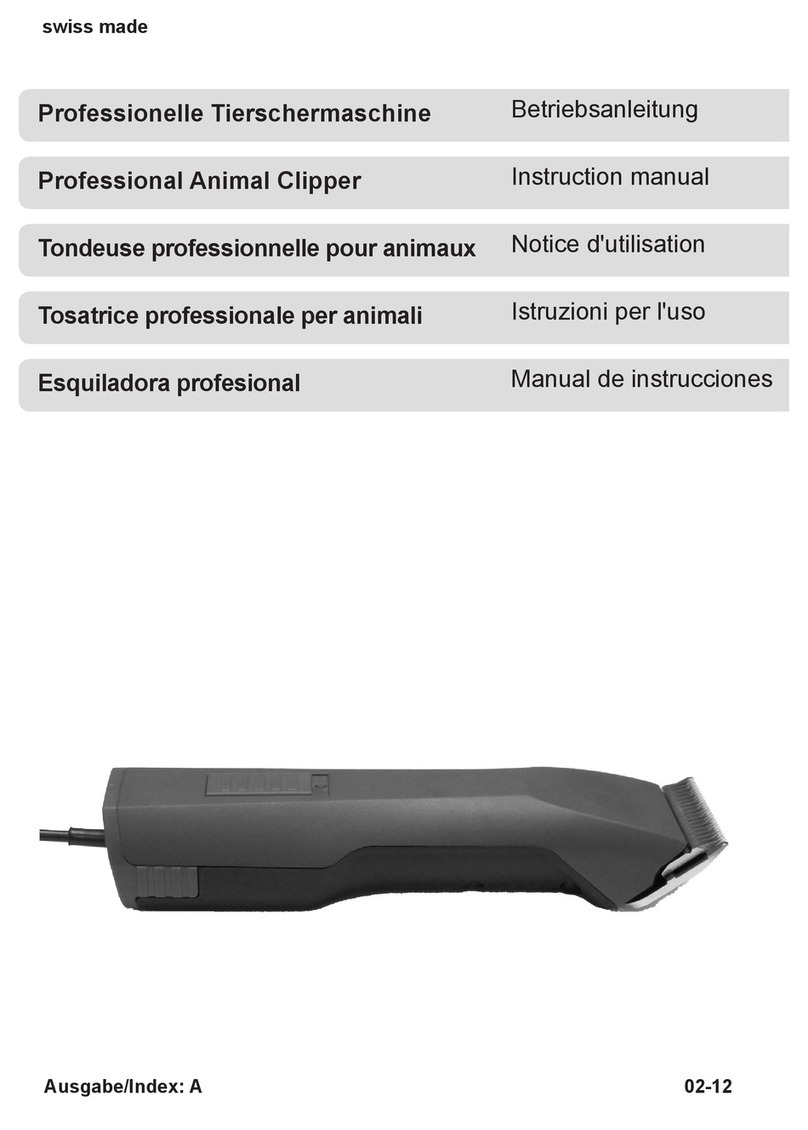
Heiniger
Heiniger SaphirCord User manual
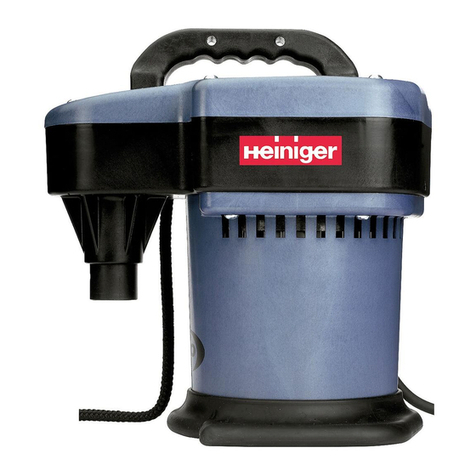
Heiniger
Heiniger EVO User manual

Heiniger
Heiniger PROGRESS User manual

Heiniger
Heiniger Handy User manual

Heiniger
Heiniger Cordless User manual

Heiniger
Heiniger Opal User manual
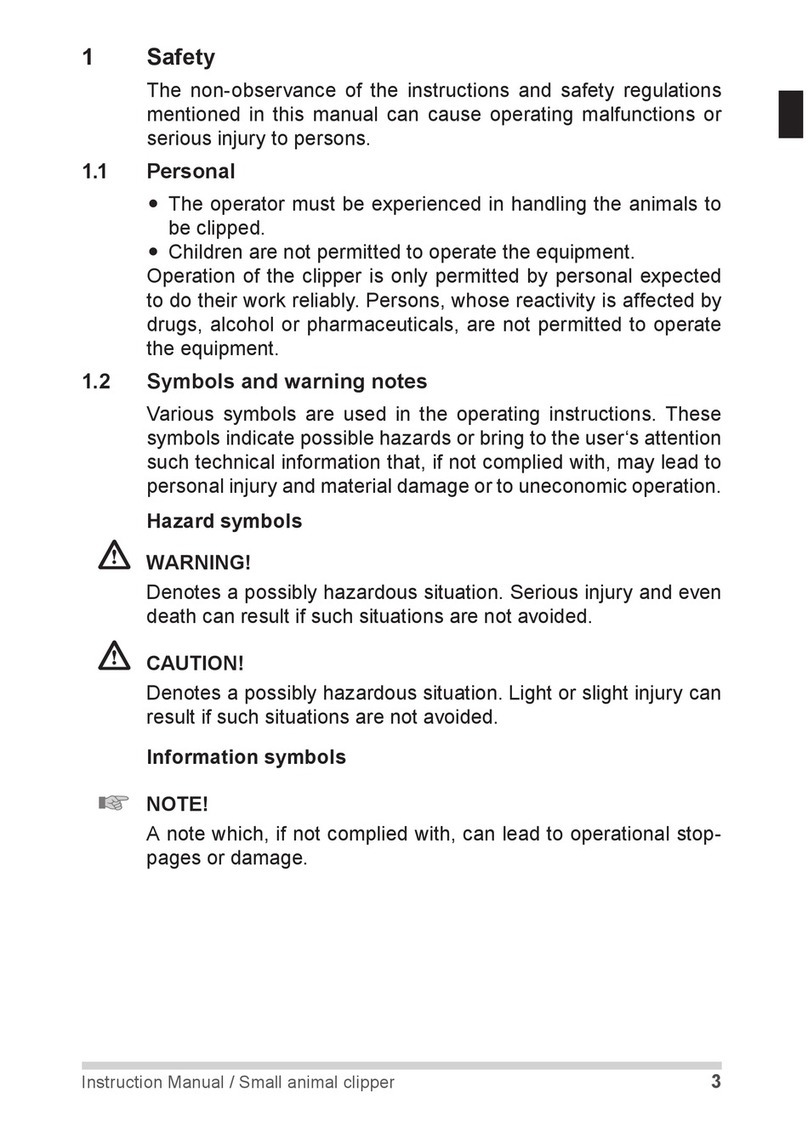
Heiniger
Heiniger saphir User manual
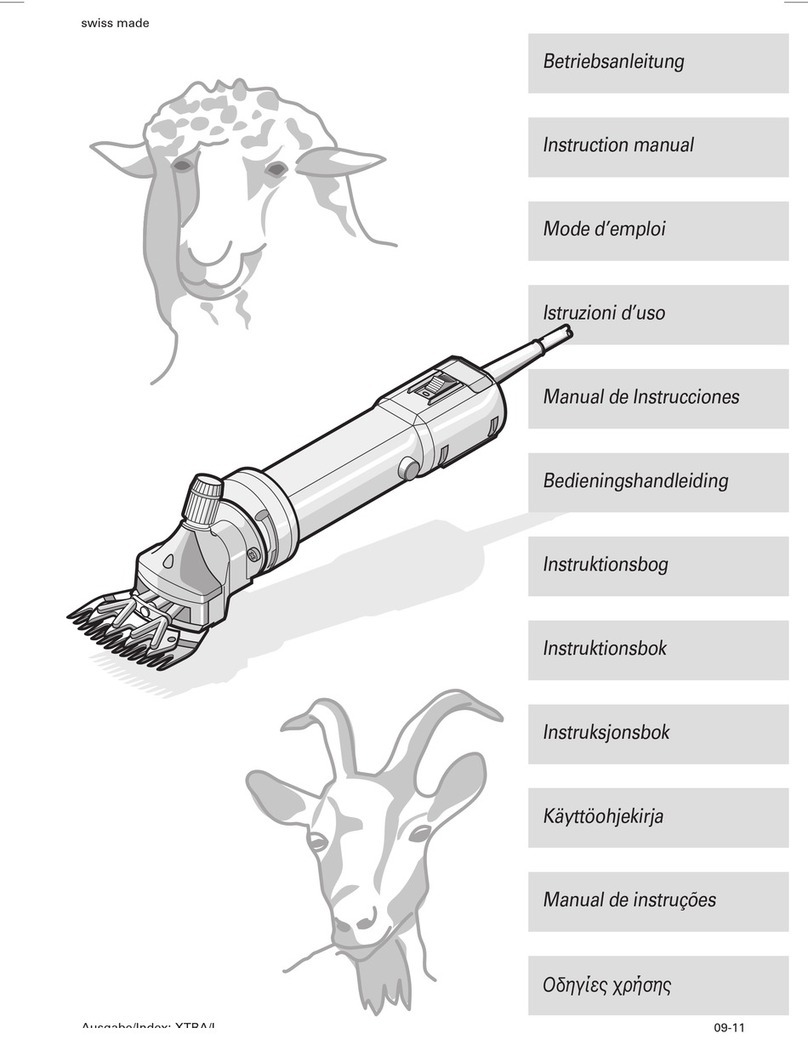
Heiniger
Heiniger XTRA VS84-S User manual
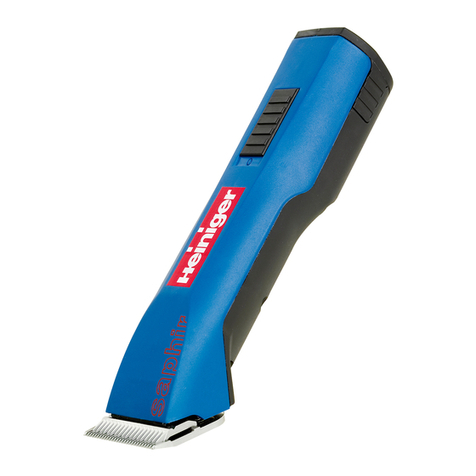
Heiniger
Heiniger Saphir series User manual
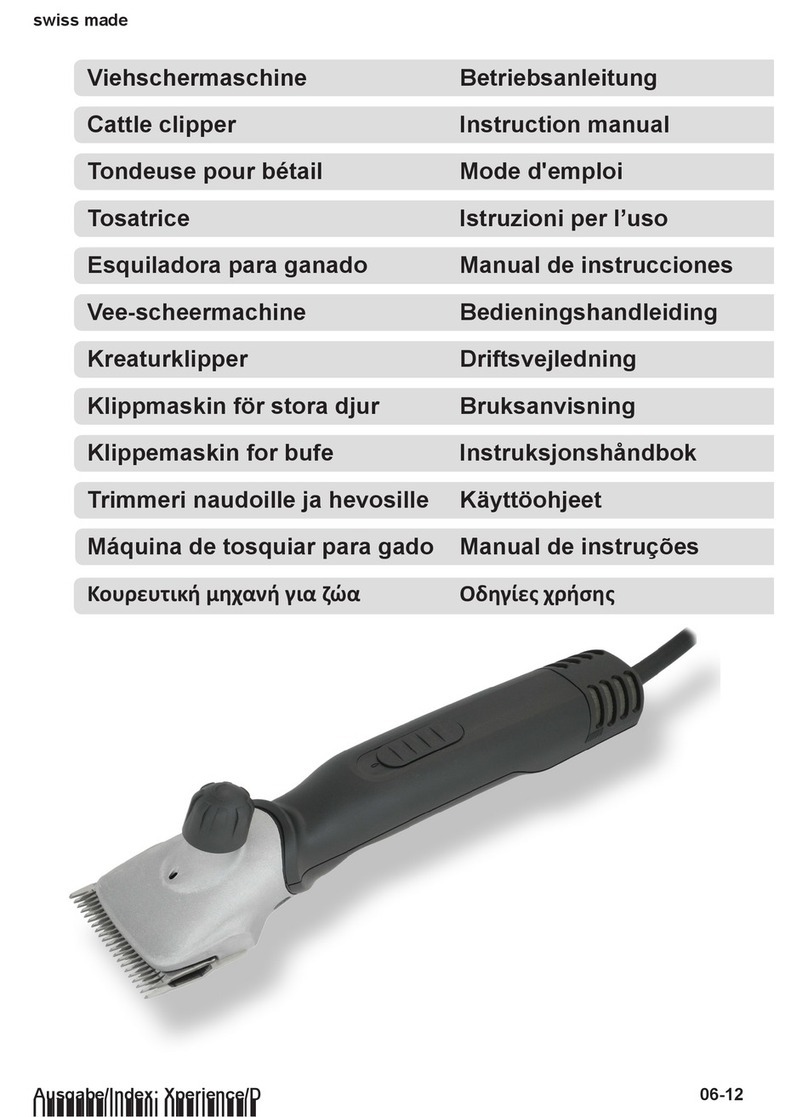
Heiniger
Heiniger Xperience User manual

